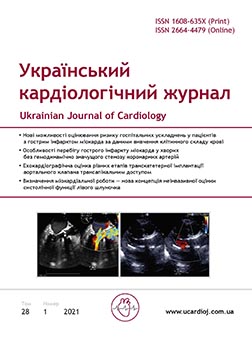Analysis of the endocrine status of patients with coronary artery disease in cardiac surgery
Main Article Content
Abstract
The aim – to analyze the endocrine status of high-risk patients with coronary artery disease in cardiac surgery.
Materials and methods. Retrospective analysis of data from random 354 high-risk patients who were operated on and discharged from M.M. Amosov National Institute of Cardiovascular Surgery of NAMS of Ukraine in the period from 2009 to 2019. The mean age of patients was 61.9±9.7 years. All patients underwent ECG, ECHO, coronary angiography and surgical myocardial revascularization with correction of concomitant cardiac pathology, if necessary. In the perioperative period all patients underwent general clinical and biochemical blood tests. Stratifying the risk according to the EuroSCORE II scale, patients belonged to the high risk group and had > 5 % probability of mortality.
Results and discussion. All patients had hemodynamically significant stenosis of the coronary arteries that required surgical revascularization of the myocardium. The analysis showed that 287 (81.07 %) patients were overweight, 281 (79.3 %) – had metabolic syndrome, 90 (25.4 %) – type 2 diabetes mellitus (type 2 DM), 161 (45.45 %) – impaired glucose tolerance. Thyroid disease was diagnosed in 37 (10.4 %) patients, 11 (3.1 %) patients had hypothyroidism. In the postoperative period, paroxysms of atrial fibrillation occurred in 83 (23.4 %) patients, of whom 70 (84.3 %) had type 2 DM and impaired glucose tolerance. Deep sternal infection occurred in 4 (4.4 %) patients with type 2 DM, for 3 (3.3 %) of them sternoplasty performed. Neurological complications – stroke and transient ischemic attack had 10 (2.8 %) patients among which 9 (90 %) had glucose metabolism disturbance. Acute renal failure occurred in 10 (2.8 %) patients, of whom 8 (80 %) had type 2 DM and pre-DM.
Conclusions. Despite the high predicted mortality on the EuroSCORE II scale – 8.82 %, the operative mortality in the study group was 0 %, which indicates a coordinated highly skilled Heart-team work, timely verification of comorbid conditions and the involvement of related specialists.
Article Details
Keywords:
References
Руденко А.В., Багиров М.М., Гогаева Е.К. та ін. Симультантная операция коронарного шунтирования с резекцией аневризмы левого желудочка и гемитиреоидэктомией // Серце і судини.– 2014.– № 2.– С. 106–111.
Cosentino F., Grant P. J., Aboyans V. et al. 2019 ESC Guidelines on diabetes, pre-diabetes, and cardiovascular diseases developed in collaboration with the EASD: the Task Force for diabetes, pre-diabetes, and cardiovascular
diseases of the European Society of Cardiology (ESC) and the European Association for the Study of Diabetes (EASD) // Eur. Heart J.– 2019.– Vol. 41 (2).– P. 255–323. doi: https://doi.org/10.1093/eurheartj/ehz486.
Jaimes M.C., Torrado L.A.A., Reyes N.F.S. et al. Hypothyro-idism is a Risk Factor for Atrial Fibrillation after Coronary Artery Bypass Graft // Braz. J. Cardiovasc. Surg.– 2017.– Vol. 32 (6).– P. 475–480. doi: https://doi.org/10.21470/1678-9741-2017-0080.
Jia F., Tian J., Deng F. et al. Subclinical hypothyroidism and the associations with macrovascular complications and chronic kidney disease in patients with Type 2 diabetes // Diabet. Med.– 2015.– Vol. 32 (8).– P. 1097–1010. doi: https://doi.org/10.1111/dme.12724.
Neumann F.J., Sousa-Uva M., Ahlsson A. et al. 2018 ESC/EACTS Guidelines on myocardial revascularization // Eur. Heart J.– 2019.– Vol. 40 (2).– P. 87–165. doi: https://doi.org/10.1093/eurheartj/ehy394.
The IDF consensus worldwide definition of the metabolic syndrome. [Last accessed on 2020 October 5]. URL: https://www.idf.org/e-library/consensus-statements/60-idfconsensus-worldwide-definitionof-the-metabolic-syndrome.
Zindrou D., Taylor K.M., Bagger J.P. Excess coronary artery bypass graft mortality among women with hypothyroidism // Ann. Thorac. Surg.– 2002.– Vol. 74 (6).– P. 2121–2125. doi: https://doi.org/10.1016/s0003-4975(02)04082-1.


